#which like. As A Boromir Enjoyer. I think is so critical
Text
look there r critiques to be made abt the characterization of movie!Faramir but he’s actually so important to me. the fact he Is tempted and that his temptation mirrors Boromir’s in that they’re both centered around love means so much to me, actually
#Boromir’s love for his people vs Faramir’s desire to be loved by Denethor#showing how much Denethor Had whittled away at Faramir.#*would* he have been tempted by the ring if he hadn’t been constantly belittled by his own father? I think that’s a valid question#or even if Boromir had been alive#in that moment Faramir had lost the one person in his direct family that cared for him genuinely and openly#like Denethor is all he had left. and Denethor cannot stand him. Denethor wishes he was dead.#*but maybe if he returns with the ring* <- and that is like. soso important to me for realsies#not to mention the arc of him overcoming the temptation before it’s too late and sending Frodo and Sam on their way#which like. As A Boromir Enjoyer. I think is so critical#like. if you raised someone. wouldn’t you hope that they’d take what they learned from you and become better? not repeat your mistakes?#Boromir adored his brother and Faramir was tempted but he didn’t fall. he learned and he became better. he didn’t repeat Boromir’s mistakes#idk I think obviously there are things that work in a book that don’t work on film and I really do enjoy movie Faramir I think they#crafted a very cool little guy#lotr
8 notes
·
View notes
Text
Books of 2020 - April
April was a strange reading month for me, on the one hand I read 10 books which is double my average 5-6 books a month! On the other I completely failed to read my OWLs Magical Readathon tbr... I did manage to read books that worked for the prompts but they weren’t the books I meant to read. Oops!
(Once again I haven’t proof read this and I’ll just apologise in advance for any mistakes, I’m lazy...)

OWLS Magical Reathon: Hogwarts Professor (what subject I specialise in will depend on the NEWTS...)
Wyrd Sisters - Terry Pratchett (Discworld #6, Witches #1)
OWLS: History of Magic
I loved reading Wyrd Sisters, it was so much fun! Pratchett retold Shakespeare’s Macbeth from the witches view point, but with his usual satirical twist. Granny Weatherwax, Nanny Ogg, and Magrat Garlick shine through the narrative, offering a no nonsense, ridiculous, and lovable take on witchcraft (or headology) as worked to protect Lancre from Duke and Duchess Felmet after they assassinated King Verence.
The Shakespeare references, puns, and reworkings in this book was sublime! I had a great time picking them out and watching as the acting company performed the most ridiculous versions of Shakespeare’s greatest works. I adored the witches - which was a bit surprising. I’d gone into this thinking I’d dislike the Witches sub-series after reading Equal Rites a couple of years ago (to this day it is my least favourite Discworld book...) However, Granny Weatherwax is a very different character here and the story is so separate from the narrative in Equal Rites that I refuse to see this book as the second installment in the Wtiches sub-series. I’d highly recommed reading Wyrd Sisters, and it would be a fantastic place to start with Pratchett if you like retellings and/or Shakespeare!
Sir Gawain and the Green Knight - Anon, trans. by J.R.R. Tolkien
OWLS: Potions
I enjoyed this translation of Sir Gawain and the Green Knight, Tolkien’s style and tone suits this style of poetry (would you call it epic? It’s more of a romance...) Tolkien brought the story in Sir Gawain to life for me, in a way I’ve never experienced in other versions I’ve read. I fell in love with this simple tale from Arthurian Legend, which I’ve never done before... It’s beautiful, simple, and captivating. I would highly recommend reading this edition if you’re interested in Sir Gawain.
The Last Hero - Terry Pratchett (Discworld #27, Rincewind and the Wizards #7)
OWLs: Astronomy
This is a book of two halves for me. The story itself is a bit too simple for my tastes... We see Cohen the Barbarian (the only Discworld character I actually hate) heading towards the Hub to return fire to the gods, however, Ankh-Morpork sends a party afte him to prevent him from destroying the Disc. This party was hilarious: Rincewind, the Librarian, Leonard of Quirrm, and Captain Carrot Ironfounderson all confined to a tiny ‘spaceship’... This was not a combination of characters I ever expected to see and their personalities, particularly Carrot and Rincewind, created several spectacularly ridiculous moments I loved! But the plot itself wasn’t great, I was expecting a bit more from Pratchett at this stage in in the Discworld.
However, the artwork in this book was stunning! It worked so well to elevate the story, I couldn’t help but love it... If the artwork hadn’t been included this book would have been a lot weaker... It’s hard to rate the book because of this, but I did really enjoy it (and hopefully this will be the last time I have to read about Cohen the Barbarian and the Silver Horde.) Also, look up Rincewind as The Scream, it’s brilliant!
We Should All Be Feminists - Chimamanda Ngozi Adichie
OWLs: Arithmancy
I usually don’t read essays for pleasure, nonfiction has been relegated to academic pursuits for the last 5ish years... Yet, this classic (I’m calling it a classic, everyone should read it) essay from Adichie was incredibly powerful. It emphasised the importance of feminism to non-western/European women and highlighted how important and beneficial feminism is for everyone. It’s a really important piece for people to read and I’d highly recommend finding the audiobook, or a reading, done by Adichie as her passion for the subject shines through her words.
Beren and Luthien - J.R.R. Tolkien (Middle Earth)
OWLs: Transfiguration
I ADORED Beren and Luthien, it was the best book I’ve read all month. I was expecting to dislike this book because of it’s formatting. It’s told through several fragmentary versions of Beren’ and Luthien’s romance that at Tolkien wrote throughout his life. Christopher Tolkien edited together 5 or 6 (maybe?) manuscripts along with his own commentary, introduction, and parts of the Earendil story to give us a fleshed out picture of Tolkien’s greatest romance. Unlike The Fall of Gondolin, which I read earlier this year, the format worked beautifully for Beren and Luthien, probably because the different versions that have survived were incredibly different and more complete.
I was feeling a bit so-so about this collection until we started seeing the Lay of Leithian (sp?) woven in between a few prose versions of the tale. The verse in the Lay of Leithian was gorgeous, it was beautiful, etherial, and passionate. I actually cried reading a few sections from it, such as the end of Felagund’s part in the tale. It was such a shame Tolkien never finished the Lay as it probably would have been his best work within the Middle Earth legend. It was captivating and the poetry suited the tone and style of Beren and Luthien’s story. The verse would have made the final acts of Luthien in the Halls of Mados exquisite, poignant, and heartbreakingly tragic.
I cannot love this book more - it might be my favourite in Middle Earth, knocking The Silmarillion off the top spot... But, I wouldn’t necessarily recommend this book for everyone. If you’re a Tolkien fanatic then I’d consider this a must read, it contains Tolkien’s most beautiful writing along with his most tragic romance! If you’re only mildly interested in Middle Earth then I don’t think you’re going to enjoy it.
The Children of Earth and Sky - Guy Gavriel Kay
OWLs: Charms
The Children of Earth and Sky was an incredibly read, it’s a powerful but understated historical fantasy set in a world based on (I presume) renaissance Italy and the Ottoman Empire at its height. There’s not a vast amount of story here, however, the character work, world building, and thematic discussion around history, religion, the ability of an individual to change the fate of nations, corruption of power, and so much more, was stunning. It was a beautiful study of characters and cultures, which was complimented by Kay’s sumptuous writing style. This was a gorgeous read!
My biggest criticism is for the romances, Kay had 4 main characters - two men and two women - and rather predictably they ended up in relationships by the end of the novel... The relationship between Danica and Marin did make more sense to me by the end of the book than the relationship between Leonora and Pero. However, both were a bit instalove-y and could have done with more development.
Nevertheless, I’d highly recommend this book! It would be an excellent read for people who aren’t fantasy fans as the fantastical elements are minor. The focus is on the historical influences, themes, and character development. It’s an excellent standalone fantasy book and I’m excited to read more of Kay’s work in the future.
The Merchant of Venice - William Shakespeare
OWLs: Divination
Most of what I could say about The Merchant of Venice has already been said before. Shakespeare’s portrayal of Shylock is incredibly problematic (I haven’t got the time or energy to go into why, but there are literally thousands of books, essays and blogposts about this, go forth and read if you want more details), the relationship between Portia and Bassanio makes NO sense, and I cannot believe that ending means anyone is going to be happy...
However, this play has a certain charm that I loved. I couldn’t help but like the relationship between Antonio and Bassanio, Portia and Nerissa are darlings, and I had fun reading the wacky plotline and (yet more) crossdressing shenanigans going on in here! I think most of my enjoyment came from the RSC version I watch alongside the play (currently availbale on Marquee TV). Either way, I’m happy to have read the play AT LAST and be one play closer to my goal of reading every Shakespeare play!
Assassin’s Apprentice - Robin Hobb (Farseer #1, Realm of the Elderlings #1)
OWLs: Defence Against the Dark Arts
We all know how I feel about Robin Hobb and the Realm of the Elderlings. I adore this world, Fitz and the Fool are (probably) the best written characters in fantasy and two of my all time favourites! I reread this for the Elderlingalong (that I somehow missed...), which gave me the perfect excuse to pick up the new 25th Anniversary edition with the GORGEOUS illustrations from Magali Villeneuve. I had a wonderful time rereading this and if you’re a fan of Hobb and you haven’t seen the work this book already you MUST get your hands on it ASAP.
Non-OWLs books
The Gathering Storm - Robert Jordan and Brandon Sanderson (Wheel of Time #12)
I wrote WAY to much to include it on this long list of books... I’ll post my thoughts on The Gathering Storm separately.
Conclusion of my ramblings: I really liked it, there were flaws in Sanderson’s writing and treatment of some characters (Mat in particular), however, it was a really good installment in the series! Sanderson really impressed me and I’m slightly nervous and very excited to read the last two books in the series!
The Fellowship of the Ring - J.R.R. Tolkien (Lord of the Rings #1)
I’ve already put up a lot of my thoughts on my latest read of The Fellowship of the Ring here. I really loved rereading this book (as I always do), I had a lot of new thoughts, and I gained a new appreciation of Boromir and Tolkien’s poetry. My annotation reread will continue in the near future with The Two Towers - I just need to clear a few urgent reads off my shelves first!
Currently Reading
Nevermore: The Trials of Morrigan Crow - Jessica Townsend
Buddy read book! I’ve actually finished this at time of posting but I’m trying to give an accurate view of my April reading!
The Long Way to a Small Angry Planet - Becky Chambers
I was supposed to read this for Arithmancy, but I didn’t get round to it... I’ve also finished this one early this month.
Words of Radiance - Brandon Sanderson
Another buddy read with @towerofleeza! We’re not the best at reading this at the same time (sorry dear!) but I think we’re both loving it, I certainly am!
Witches Abroad - Terry Pratchett
I couldn’t help myself I needed more of the Witches! I’ve also finished this one at time of posting this and enjoyed it.
#books of 2020#reading#bookblr#mini book review#Terry Pratchett#pterry#Discworld#witches#wyrd sisters#witches abroad#JRR Tolkien#tolkien#middle earth#lotr#lord of the rings#fellowship of the ring#sir gawain and the green knight#the last hero#Rincewind the Wizzard#rincewind and the wizards#chimamanda ngozi adichie#we should all be feminists#beren and luthien#guy gavriel kay#the children of earth and sky#shakespeare#william shakespeare#the merchant of venice#robin hobb#Realm of the Elderlings
10 notes
·
View notes
Text
Faramir Fridays
ok.. I have some time today and thought I would get back to regular posts if possible, and remembering that I never did get around to posting from my TVM talk, I decided that is what I shall cover today--- my hypothesis of how the character came to be.
It will be about 17 images of the slides from the talk..and a few written points..so after the first few I will put them under a cut... (note: not to be reproduced without permission)
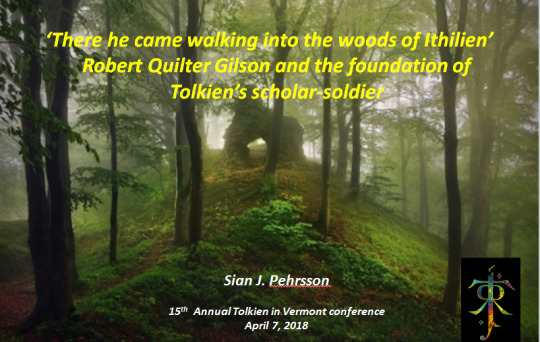
Faramir, Tolkien’s sensitive, reluctant warrior who declines the Ring, arrived quite late in the story of The Two Towers, appearing suddenly, and to Tolkien’s surprise, at a pivotal moment in the creation of the chapters ‘Of Herbs and Stewed Rabbit’ and ‘Window on the West’.


Ithilien’s Captain of record at that point, one Falborn, son of Anborn, was just finalizing his interrogation of Frodo and had been amusingly dressed down by Sam, when much lore and history of Gondor and Numenor began to be discussed. And, although a substantial part inevitably was cut to go into the Appendices, there was much that JRR wished to keep. To do that he needed a new character

The name Faramir is most commonly translated as ‘sufficient jewel’ from ‘mire’ the Quenya for jewel and ‘far’ the Sindarin for sufficient or enough. In the Peter Jackson version of the character this was a deliberate slight, that he was essentially lesser than Boromir—the steadfast jewel. Perhaps, there can be a different take. If name is destiny, Faramir, named for a Prince of Gondor who defied his father’s orders, is actually, quite simply, enough. A modest, yet noble man, with just the wisdom to resist the Ring and a play a pivotal part in Sam and Frodo’s story.
Despite this, and his enduring place as the most popular minor male character, Faramir has not often been a subject of critical analysis.
The character was conceived of and came to fruition in less than a week in early May 1944 and the relevant chapter, ‘Window on the West’, according to Christopher Tolkien, was written at great speed. May 4th there was no thought of him but by 11th he had appeared. How was an author famously obsessive about revising, one who took a decade and half between first sentence and finalized manuscript (and in so doing converted his protagonist from a hobbit called Trotter to a scion of Numenor) able to fully realize such an enduring resonant character so swiftly?

I suggest to you that it was because he had a model to draw from…. his childhood friend Robert Quilter Gilson

Robert Gilson, an artist and designer, was a member of the famous ‘Tea Club and Barrovian Society’. Hewas born in 1893 in Harrow on Hill, where his father, Cary Gilson, taught Classics. In 1900 the family moved to Marston Green when Cary became Headmaster of King Edward’s school. There, the TCBS tight circle formed, and like the others of the group, he went on to study Classics at Trinity College. His letters are a wealth of knowledge. He wrote daily, to family and friends, from university and from the Front where he served as a Lieutenant in the Suffolk regiment. He shared many qualities with Tolkien: a love of lore, and antiquity and history, but also strikingly many more with Ithilien’s Ranger.
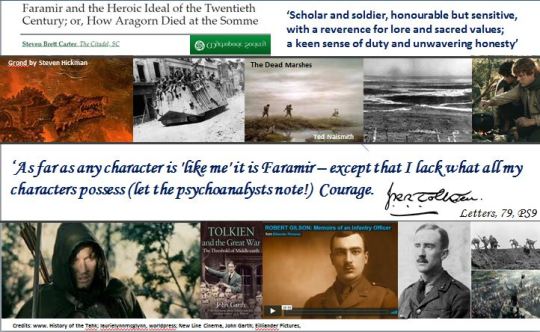
The influence of Tolkien’s war on his writing is fertile ground for study, be it the allegory of evil mechanization in Grond; or more direct examples in his imagery of the Dead Marshes, or Sam—the doughty british batman. Tolkien was part of a generation turned their grief to work, from Everest expeditions to his own scholarship-- it was a fertile time after that great conflagration.
With respect to Faramir much has been made about him as the embodiment of a modern warrior archetype, and Tolkien, when asked by a pesky journalist which character, presumably Gandalf, he was most like, replied “Faramir,” noting though, that he lacked the character’s essential courage.
I am going to suggest that Tolkien drew on a man very like him in many ways but one who also was demonstrably courageous: Gilson.
Creating characters readers connect with is one of most important challenges for a fiction writer, for a good use of characterization always leads the audience to relate better to the events taking place in the story. Physical and psychological traits, sociological and biographical details all lend themselves to creating character. Much of what we know about Faramir in the book comes from indirect characterization.. through the lens of Sam and Frodo, how he relates to them, and they to him, and his own actions. This approach is considered more effective because it slowly discloses the inner turmoil of the character, over the course of the narrative and lets the audience understand.
For the process of this I like Alexandra Sokoloff’s quote:
‘I think all writers are always collecting characters as we go along...[stored in] the back of our minds like the shelves full of buttons and ribbons and fabrics and threads and beads in a costumer’s shop.’
This surely lends richness…but also requires one has the 'bobs and buttons’ stored.
Below I shall compare the two men, real and fictional, through the lens of the character components outlined above.
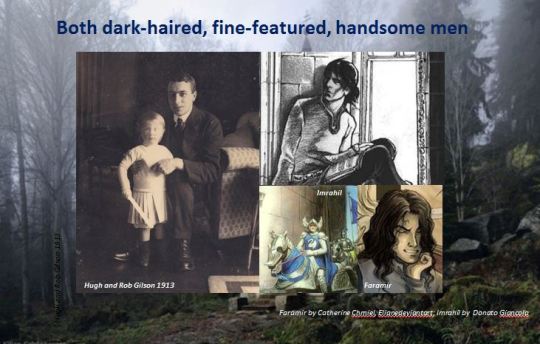
First are superficial similarities…
Faramir is typically depicted as more finely featured then his brother..an influence artists pick up, presumably from Finduilas of Dol Amroth and her descent from the elleth Mithrellas and Imrazor, the first Prince. In fact, Legolas remarks on Imrahil’s elven features in RoTK. Gilson had something of the Numenorean look given to Faramir: fine features, dark haired, and, as John Garth notes, calmly apprising eyes; a feature remarked of Faramir by number of characters in book.

Next we consider psychological traits. The above slide and below, via direct quotes from letters and the books, and John Garth’s extensive overview of Gilson’s own letters, illustrates a number of key commonalities.

Both were good leaders, loyal yet also thoughtful and poetic, but for Gilson this new role did not come naturally: he agonized over it. In a moving letter from Albert Bradman, his batman, to Cary Gilson, Bradman noted that Robert was ‘loved by all the men in the Platoon, and I may say Company, as he was a very good officer and a good leader.’
Of course, Pippin’s thoughts when first viewing Faramir, bowed and weary, at the entrance to the citadel run this very way.
There are sociological similarities between them as well. Both were conservative, as was typical of men of their social rank; pacifists and compassionate by nature, at ease across society and with people of every class.
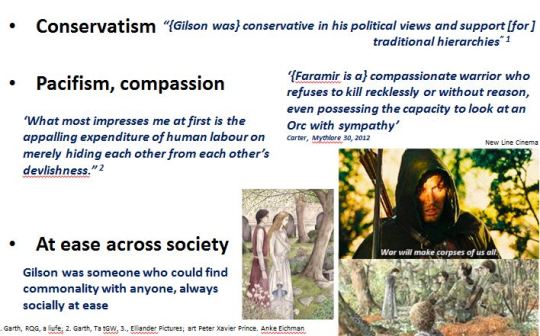
Both had a love of the archaic. For Faramir it is exemplified by his words to Sam and Frodo, and in his delight in tutelage by Mithrandir. Gilson, similarly loved an earlier time, for him it was Renaissance painting and sculpture and 18th century Neoclassical styles that looked back to earlier era. Both men enjoyed atypical, one could say unsoldierly pursuits. For Gilson it was art, design and even embroidery. For Faramir this was music and lore. Tolkien speaks of this deliberately, that these pursuits made men superficially judge him less courageous.
Both have a reverence for wild spaces and living things. Faramir was quite evidently at home in Ithilien and dreamt of making it the garden of Gondor once again. Gilson, restricted in what he could say in his letters from the Front, spoke frequently of his enjoyment of being on the move, in the beauty of the French countryside.

Both were modern soldiers in the sense used by Stephen Carter-- highly skilled, yet classically trained and not caught by conventional views of martial glory. Both were marksmen. Gilson’s eye for artistic detail transferred to riflery, where he won the Shooting 8 of the Officer Training Corps.

It is in their biographical details that the similarities become almost uncanny. Like the classical element of fairy stories, both lose a parent, their mothers, at a young age. Both men lived under the shadow of important, larger-than-life fathers who were the ‘rulers’ of their worlds. Faramir's being the ruling Steward and scion of Numenor; Gilson’s the headmaster of King Edward’s school,’ the self-contained world in which Tolkien and Gilson lived. Cary Gilson was an intimidating, formidable man, who moved in important circles but unlike Denethor, loved his son greatly, however much, in keeping with his era, he did not show it publically.
Gilson, like Faramir, followed his duty, if not his heart. The first of the TCBS to enlist, he left Cambridge where he had undertaken studies chosen for him by his father. Like Faramir, he struggled to live up to parental expectation at times, finding it hard to achieve grades expected in a subject he did not love. Ultimately he was confident enough to defy his father’s will and societal convention: just before the war, he announced he would give up Classics to study Architecture…something considered a ‘trade’ in those days, not a vocation.
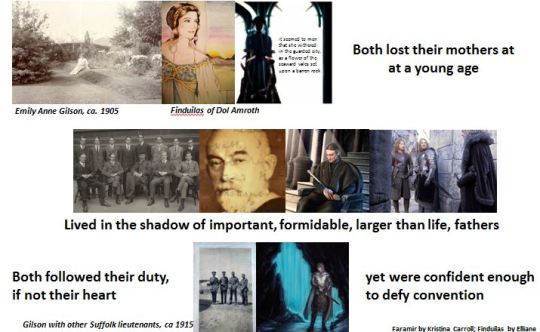
Both loved above their station and were initially rebuffed. Faramir’s true love is of course Eowyn of Rohan, niece of, and sister to, a King, Gilson’s was Estelle King, the daughter of the American Consul. They became friends on holidays in the Scottish Highlands but she was at first utterly shocked and flummoxed by his declaration of love. Gilson went off to France thinking his suit was lost but it was not so. On shore leave they became engaged. Letters between Gilson and the adventurous King, who was serving in Holland as a nurse, detail and deep affinity.
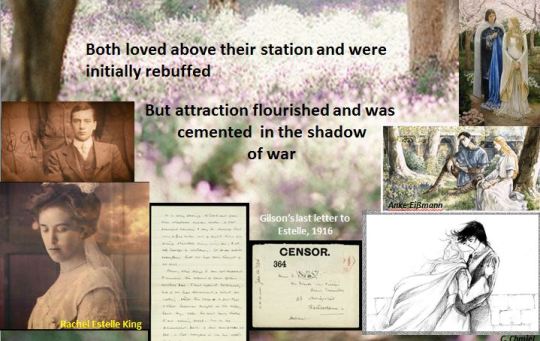
Most heartbreaking of all is the echo of Gilson in Faramir’s charge on Osgiliath: another personally courageous scholar-soldier, calmly leading his men against overwhelming odds into a rain of endless slaughter. Gilson’s battalion went over the top the first morning of the first day of the battle of the Somme, one that would in live infamy. Gilson, the last officer surviving in the midst of battle, he unflinchingly and briefly took over leadership of the entire company. The Suffolk Regiment’s loss that day was the largest of any single battalion in their division. 70% of the officers and 50% of men, far greater than Gondor’s retreat.
Unlike Faramir, Gilson did not survive. He was killed by a shell burst that morn.
Tolkien said of his friend’s death that ‘something has gone crack’, and it was so seminal a loss that for the first time in a decade he said he felt ‘a mere individual’.
Geoffrey Bache Smith of the TCBS memorialized Rob in his poem “Let us tell quiet stories of kind eyes”

To conclude, I suggest Tolkien was able to paint such a resonant portrait in so short a time, to develop a fine characterization of a sensitive poet-soldier, adored by his men, driven by duty to do what goes against his nature, by drawing upon one he knew in life, subconsiously or otherwise. And in this we have another influence of the Great War and his childhood friends on Tolkien’s work.

Acknowledgements and Sources below:
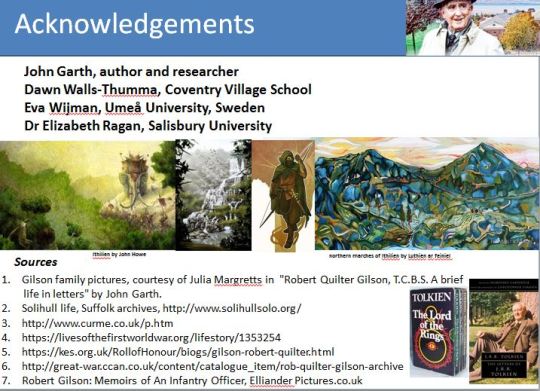
45 notes
·
View notes